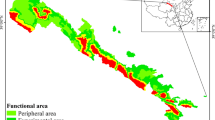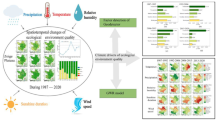Abstract
Land cover in the Chinese Loess Plateau has undergone dramatic changes since the late 1980s. Revealing the trend in land cover change and eco-environmental quality response of different geomorphic units in this stage is a realistic requirement for promoting sustainable development of the Chinese Loess Plateau. Based on the data of geomorphic units and land cover in 1990, 2000, 2010 and 2018 of the Chinese Loess Plateau, we studied the trend of land cover change and eco-environmental quality response of different geomorphic units by using a significance index of land cover change, a proportion index of land cover change and an eco-environmental response model. The results indicated that from 1990 to 2018, the areas of forestland and construction land substantially increased, whereas those of cropland, grassland, wetland and unused land considerably decreased. Land cover change exhibited large geomorphic differences, and the main conversion of land cover was from cropland into other land types. Unstable trend of land cover change in the loess tablelands and sandy loess hills declined, whereas the unstable trends in the other geomorphic units enhanced. Eco-environmental quality varied among different geomorphic units. The expansion of construction land and degradation of forestland, grassland and wetland resulted in the deterioration of eco-environmental quality. The conversion of cropland and unused land into forestland and grassland, and the conversion of grassland into forestland were the main factors that drove the improvement of eco-environmental quality. The findings of this study may provide theoretical reference and support decision making for the optimization of land use structure and the improvement of eco-environmental quality on the Chinese Loess Plateau.
Similar content being viewed by others
References
Bičík I, Kupková L, Jeleček L, et al. 2015. Land Use Changes in the Czech Republic 1845–2010. Switzerland: Springer, 95–170.
Brierley G, Stankoviansky M. 2003. Geomorphic responses to land use change. Catena, 51(3–4): 173–179.
Bryan B A, Gao L, Ye Y Q, et al. 2018. China’s response to a national land-system sustainability emergency. Nature, 559(7713): 193–204.
CAS (Chinese Academy of Sciences), China’s Natural Geographic Editor Committee (CNGEC). 1980. China’s Natural Geographical Landscape. Beijing: Science Press, 15–20. (in Chinese)
Chen W T, Wang Y X, Li X J, et al. 2016. Land use/land cover change and driving effects of water environment system in Dunhuang Basin, northwestern China. Environmental Earth Sciences, 75: 1027.
CSNR (China Society of Natural Resources). 2018. Report on Advances in Resources Science (2016–2017). Beijing: China Science and Technology Press, 106–107. (in Chinese)
Deng L, Liu G B, Shangguan Z P. 2014. Land-use conversion and changing soil carbon stocksin China’s ‘Grain-for-Green’ program: A synthesis. Global Change Biology, 20(11): 3544–3556.
Fu B J. 2019. The project of returning farmland to forests has enabled the Loess Plateau to achieve a “win-win” situation for ecological environmental protection and social economic development. Yan’an Daily, 2004-08-13. (in Chinese)
Gao H D, Li Z B, Jia L L, et al. 2016. Capacity of soil loss control in the Loess Plateau based on soil erosion control degree. Journal of Geographical Sciences, 26(4): 457–472.
GAPRCEC (Geomorphologic Atlas of the People’s Republic of China Editor Committee). 2009. The Geomorphologic Atlas of the People’s Republic of China (1:1,000,000). Beijing: Science Press, 23. (in Chinese)
Ge Q S, Dai J H, He F N, et al. 2008. The research of land use/cover change and carbon cycle of China in the past 300 years. Science in China: Earth Science, 38(2):197–210. (in Chinese)
GLP (Global Land Project). 2005. Global land project: Science plan and implementation strategy. In: IGBP Report No. 53/IHDP Report No. 19, IGBP Secretariat, Stockholm.
Guo B Y, Wang G Q, Fu X D, et al. 2012. Spatial structure and fractal model of land use in Qingjian river basin of middle Yellow River. Transaction of the Chinese Society of Agricultural Engineering, 28(14): 223–228. (in Chinese)
He W C, Zhao S M, Cheng W M. 2016. Analysis of land cover change on basic geomorphic types in Shanxi province. Journal of Geo-Information Science, 18(2): 210–219. (in Chinese)
Janssen L L F, Vander Welf F J M. Accuracy assessment of satellite derived land-cover data: A review. Photogram metric Engineering and Remote Sensing, 1994, 60: 419–426.
Jin Z. 2019. Ecological restoration and management in the Loess Plateau entering the new era. Journal of Earth Environment, 10(3): 316–322. (in Chinese)
Kalnay E, Cai M. 2003. Impact of urbanization and land-use change on climate. Nature, 423(6939): 528–531.
Kong D X, Miao C Y, Borthwick A G L, et al. 2018. Spatiotemporal variations in vegetation cover on the Loess Plateau, China, between 1982 and 2013: possible causes and potential impacts. Environmental Science and Pollution Research, 25(14): 13633–13644.
Lambin E F, Baulies X, Bockstael N, et al. 1995. Land-use and land-cover change (LUCC): Implementation strategy. In: A core project of the International Geosphere-Biosphere Programme and the International Human Dimensions Programme on Global Environmental Change. IGBP Report 48. IHDP Report 10. IGBP, Stockholm, 125.
Lawler J J, Lewis J D, Nelson E, et al. 2014. Projected land-use change impacts on ecosystem services in the United States. Proceedings of the National Academy of Sciences, 111(20): 7492–7497.
Li J J, Li Z, Lü Z M. 2016. Analysis of spatiotemporal variations in land use on the Loess Plateau of China during 1986–2010. Environmental Earth Sciences, 75(11): 2–12.
Li Z, Liu W Z, Zheng F L. 2013. The land use changes and its relationship with topographic factors in the Jing river catchment on the Loess Plateau of China. Springer Plus, 2(S1): S3.
Liu G B, Shangguan Z P, Yao W Y, et al. 2017. Ecological effects of soil conservation in Loess Plateau. Bulletin of Chinese Academy of Sciences, 32(1): 11–19. (in Chinese)
Liu J F, Sun H, Chang G Q, et al. 2014. Research on national investment policy and mechanism of ecological security in the Loess Plateau. Soil and Water Conservation, (4): 23–27. (in Chinese)
Liu J Y, Kuang W H, Zhang Z X, et al. 2014. Spatiotemporal characteristics, patterns, and causes of land-use changes in China since the late 1980s. Journal of Geographical Sciences. 24 (2): 195–210.
Liu M X, Zhao R D, Shao P, et al. 2018. Temporal and spatial variation of vegetation coverage and its driving forces in the Loess Plateau from 2001 to 2015. Arid Land Geography, 41(1): 99–108. (in Chinese)
Lv L G, Zhou S L, Zhou B B, et al. 2013. Land use transformation and its eco-environmental response in process of the regional development: A case study of Jiangsu province. Scientia Geographica Sinica, 33(12): 1442–1449. (in Chinese)
Luo Y, Yang S T, Liu X Y, et al. 2014. Land use change in the reach from Hekouzhen to Tongguan of the Yellow River during 1998–2010. Acta Geographic Sinica, 69(1): 42–53.
Mayer W B, Turner B L. 1994. Changes in Land Use and Land Cover: A Global Perspective. New York: Cambridge University Press, 537–538.
Mooney H A, Duraiappah A, Larigauderie A. 2013. Evolution of natural and social science interactions in global change research programs. Proceedings of the National Academy of Sciences, 110(Suppl. 1): 3665–3672.
Ning J, Liu J Y, Kuang W H, et al. 2018. Spatiotemporal patterns and characteristics of land-use change in China during 2010–2015. Journal of Geographical Sciences, 28(5): 547–562.
Reid W V, Chen D, Goldfarb L, et al. 2010. Earth system science for global sustainability: grand challenges. Science, 330(6006): 916–917.
Shi H, Shao M. 2000. Soil and water loss from the Loess Plateau in China. Journal of Arid Environments, 45(1): 9–20.
Song W, Deng X Z. 2017. Land-use/land-cover change and ecosystem service provision in China. Science of the Total Environment, 576: 705–719.
Song Y Y, Xue D Q, Dai L H, et al. 2018. Land use change and its ecological response in typical fossil energy development zones of Shanxi-Shaanxi-Inner Mongolia. Arid Zone Research, 35(5): 1–9. (in Chinese)
Turner B L, Skole D, Sanderson S, et al. 1995. Land use and land cover change science/research plan. In: IGBP Report No. 35, IHDP Report 7. Stockholm, Geneva, 61–78.
Turner B L, Lambin E F, Reenberg A. 2007. The emergence of land change science for global environmental change and sustainability. Proceeding of the National Academy of Sciences, 104(52): 20666–20671.
Verbuerg P H, Chen Y Q. 2000. Multiscale characterization of land use patterns in China. Ecosystems, 3(4): 369–385.
Waisanen P J, Bliss N B. 2002. Changes in population and agricultural land in conterminous United States counties, 1790 to 1997. Global Biogeochemical Cycle, 16(4): 1–15.
Wang S, Fu B J, Piao S L, et al. 2016. Reduced sediment transport in the Yellow River due to anthropogenic changes. Nature Geoscience, 9(1): 38–41.
Wu L N, Yang S T, Liu X Y, et al. 2014. Response analysis of land use change to the degree of human activities in Beiluo River basin since 1976. Acta Geographica Sinica, 69(1): 54–63. (in Chinese)
Xie G D, Lu C X, Leng Y F, et al. 2003. Ecological assets valuation of the Tibetan Plateau. Journal of Natural Resources, 18(2): 189–196. (in Chinese)
Zhang J X, Zhang D Y, Zhang B, et al. 2015. Vegetation landscape change and its multi-scale response relationship with terrain in Loess Plateau. Chinese Journal of Ecology, 34(3): 611–620. (in Chinese)
Zhang K, Lü Y H, Fu B J. 2017. Vegetation restoration and its influences on ecosystem services in areas typical of the Loess Plateau. Journal of Ecology and Rural Environment, 33(1): 23–31. (in Chinese)
Zhang X R, Liu L P, Fang S, et al. 2014. Research advances on the relationship between land use/cover change and environmental change. Ecological and Environment Science, 23(12): 2013–2021. (in Chinese)
Zhao G, Mu X, Wen Z, et al. 2013. Soil erosion, conservation, and eco-environment changes in the Loess Plateau of China. Land Degradation and Development, 24(5): 499–510.
Zhao M, Cheng W M, Huang K, et al. 2016. Research on land cover change in Beijing-Tianjin-Hebei region during the last 10 years based on different geomorphic units. Journal of Natural Resources, 31(2): 251–264. (in Chinese)
Zhong D Y, Chang Q R, Song F J. 2012. Relationship between terrain factors and spatial distribution of land use hilly and gully area. Journal of Arid Land Resources and Environment, 26(6): 102–107. (in Chinese)
Zhou S G, Shao Q Q, Cao W. 2016. Characteristics of land use and land cover change in the Loess Plateau over the past 20 years. Journal of Geo-Information Science, 18(2): 190–199. (in Chinese)
Acknowledgements
This research was funded by the Special Project of the Ministry of Science and Technology of China (2014FY210100), the National Key Research and Development Program of China (2018YFD1100101) and the National Natural Science Foundation of China (41971204).
Author information
Authors and Affiliations
Corresponding author
Rights and permissions
About this article
Cite this article
Song, Y., Xue, D., Dai, L. et al. Land cover change and eco-environmental quality response of different geomorphic units on the Chinese Loess Plateau. J. Arid Land 12, 29–43 (2020). https://doi.org/10.1007/s40333-019-0031-8
Received:
Revised:
Accepted:
Published:
Issue Date:
DOI: https://doi.org/10.1007/s40333-019-0031-8




